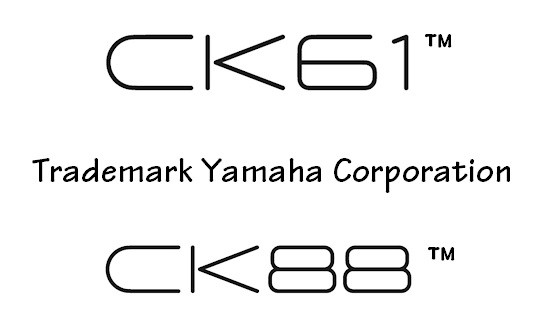Thanks to Saul’s recent post at Yamaha Musicians Forum, it looks like tomorrow is the day for CK.
By Tuesday evening, we’ll all be laughing at the ridiculous predictions and wishful thinking that we’ve all posted.
So, here’s some more wishful thinking. 🙂
Knowing the price points, about $1,250 USD for the 61 and $1,920 for the 88, we instantly know that these aren’t the droids some people have been looking for. At these prices, the CKs impinge on the entry-level niche held by the long-in-the-tooth MX series. Yamaha may have decided to spiff up and bulk up the MX to CK in order to establish higher margins at the entry-level without blowing up the magic $1,000 barrier. [I have some reason to believe that the rumored prices are MSRP.]

At such low price points, forget an FSX keybed, aftertouch, a large touch display, etc. I suspect that Yamaha engineers chose one of its proprietary SWX processors instead of the higher spec SWP70 which is the mainstay of mid- and high-end Yamaha keyboards. The SWX series integrates the host processor, display interface, USB interface and AWM2 tone generator into a single integrated circuit package. Reface YC, Reface CP and first-gen MX are based on an earlier version of SWX (SWX08). The current rev is SWX09.
The word “portable” in the terse CK description might imply an internal battery power option. Choosing SWX would at least give the engineers a fighting chance at low power. I suspect that the SWP70 tone generator is a bit of a power hog. Yamaha do not currently offer a battery-powered synth while some competitors do (e.g., Roland JUNO DS61). I would love battery power for rehearsals — anything to make the schlep and set-up easier.
Part of the MX pitch is “controller integration.” Yamaha currently do not offer a MIDI controller with all the front panel knobs, sliders, widgets and gizmos that warm the heart. Even though Yamaha tout the MX for control, it’s really feature poor in comparison to most full size MIDI controllers. Although the MX is reasonably well-integrated with Cubase, more people are running virtual instruments on IOS/Android tablets/phones instead of laptops. Yamaha must (should) respond to these trends.
I often wonder why Yamaha haven’t put forth a Halion-based version of Arturia’s wonderful V Collection or Analog Lab? I was immediately impressed by the integration of Analog Lab with Arturia Keylab Essential. Yamaha have been missing an opportunity here.
Up to this point, Yamaha seem reluctant to offer an all-in-one stage keyboard combining, piano, organ and synth. As a player, you’re forced into a multi-keyboard “top and bottom” rig decision. Implications are many. If organ or piano are your main need, then perhaps you choose a YCxx or CPxx for the bottom. Neither ‘board provides comprehensive synth sounds, so you need a synth for the top. Maybe a CK61™?
Schlep and cost are major factors. Two keyboards is a lot more trouble and cost than one. The keyboard stand is bigger and heavier. Yada-yada. For me, I play in an incredibly small space and, as an older adult, my body is whacked out from hauling gear! Cost is another big factor as I don’t want to tie up funds in idle keyboards — no matter how pretty they are. 🙂
So, maybe I will view the CK61™ as a Korg Triton Taktile on steroids. The Triton Taktile 49 was a light-weight controller with lots of knobs and sliders, and had a “courtesy” Triton engine. The Triton Taktile had its disdvantages — no way to store user edits, no internal battery power. The CK likely avoids these pitfalls in which case a CK plus an iPad (Camelot, Korg Module, iSymphonic, SWAM) might do the trick as a light-weight stage gig rig.
As to that “all-in-one,” might that be the Montage successor? Yamaha was slow to follow Motif XF (August 2010) with Montage (January 2016), so the wait for the Montage successor is not that surprising. Plus, you don’t really think you’re getting AN-X™ for free, do you? 🙂
Copyright © 2023 Paul J. Drongowski
